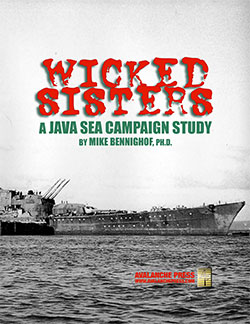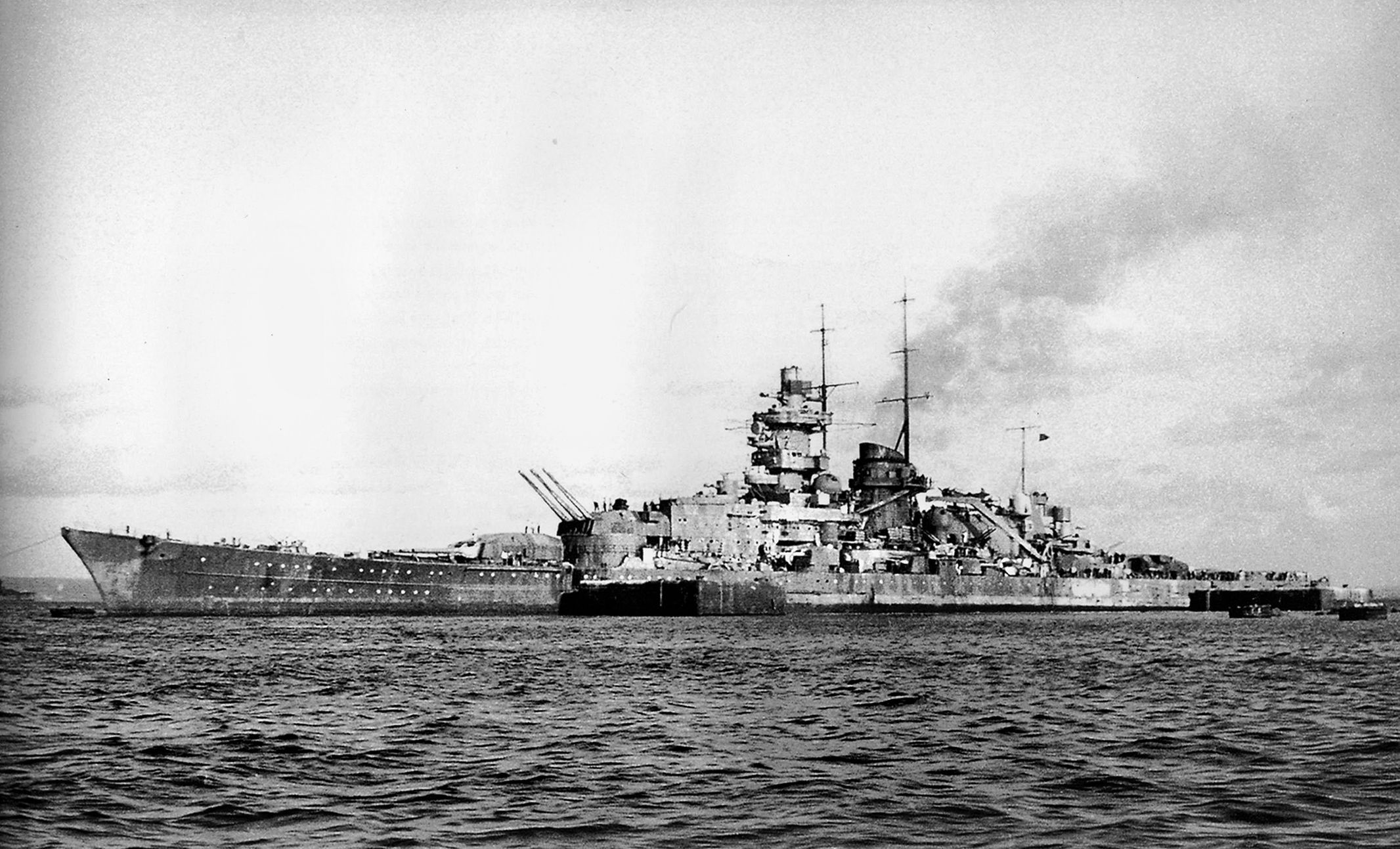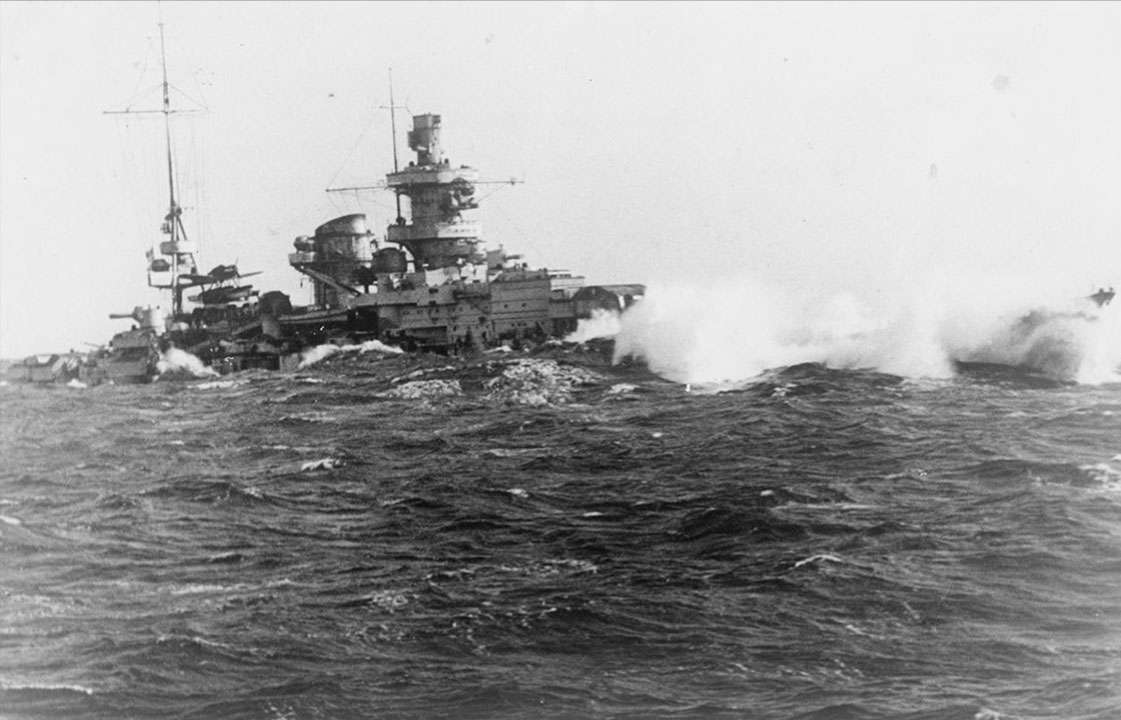Wicked Sisters:
Publisher’s Preview
by Mike Bennighof, Ph.D.
October 2023
 Sometimes, the stupid ideas of historical figures make for the best game concepts. Sometimes, the stupid ideas of historical figures make for the best game concepts.
In early 1942, the German Navy had three of its most powerful ships – the battle cruisers Scharnhorst and Gneisenau and the heavy cruiser Prinz Eugen – at Brest in western France, just a short distance away from the airfields housing British bombers. The Royal Air Force made repeated attempts to bomb the ships as they lay in port, while the German Air Force gave them grossly inadequate fighter protection.
Given the choice of leaving them in Brest to be steadily pounded into scrap or bringing them home where they would both be safer from air attack and might be deployed more profitably, the German Navy began to prepare a mad dash from Brest to Wilhelmshaven. After considering several alternatives, in February 1942 the three ships plus escorting light craft shot up the English Channel in broad daylight. Scharnhorst and Prinz Eugen saw further service, but Gneisenau suffered damage that would never be repaired.
With thousands of French dock workers entering and leaving the base at Brest every day, the Germans couldn’t hide that the ships were being readied to go somewhere. The cover story claimed that they would be sent around the world to join the Japanese in the Dutch East Indies, and rather clumsy moves – like loading crates of pith helmets for the crews – tried to support this tale.
That voyage never happened, of course. But in our Campaign Study, Java Sea: Wicked Sisters, that’s exactly where the German ships end up. Steaming down the full length of the Atlantic, around the Cape of Good Hope, across the Indian Ocean all the way to Singapore.
 German surface raiders did operate in the Indian Ocean and even the Pacific, but those were either long-range armored cruisers (popularly known as “pocket battleships”) powered by diesel engines, or converted merchant ships that could re-fuel from a supply ship or even a prize. The latter could remain at sea for greatly extended periods – the raider Komet steamed around the globe for nearly a year and a half, though only claiming seven ships during that period. German surface raiders did operate in the Indian Ocean and even the Pacific, but those were either long-range armored cruisers (popularly known as “pocket battleships”) powered by diesel engines, or converted merchant ships that could re-fuel from a supply ship or even a prize. The latter could remain at sea for greatly extended periods – the raider Komet steamed around the globe for nearly a year and a half, though only claiming seven ships during that period.
The two battle cruisers operated off the West African coast during Operation Berlin in early 1941, but did not cross the Equator. Even then, they required frequent refueling from German tankers that had slipped past the British blockade.
A year later, the German ability to set up a daisy chain of such tankers, even in the relatively nearby waters of the North Atlantic, had greatly diminished. Following the brief Atlantic cruise of the battleship Bismarck, the Royal Navy had undertaken intense operations using Ultra intelligence to hunt down the tankers that had been positioned to fuel the German ship. Another had been lost in the British commando raid on St. Nazaire, and in general the British blockade had tightened on the air and sea as they sought to prevent the re-supply of German submarines.
Getting the German ships through the Atlantic and into the Indian Ocean would be a very risky proposition, one more likely to end with them scuttled off Montevideo like the failed raider Admiral Graf Spee than arriving in the Far East to commit mayhem against the British and Americans. The German penchant for blathering operational details by radio, where the Allies could intercept them and break their codes, would also give away their route and suggest plentiful locations where they might be found.
But assuming that those problems could be overcome, the German squadron could arrive off the southern exit of the Red Sea in about 45 days, there to disrupt communications through the Suez Canal. Or they could steam into Singapore in about 60 days. All of that assuming no enemy interceptions or major machinery malfunctions. The two battle cruisers had remained at sea for 59 days during Operation Berlin, so they obviously could stand the strain of the voyage, given re-supply opportunities.

Battle cruiser Gneisenau returning from Operation Berlin.
Once they arrived, re-supply would become a problem. They could of course obtain food and fuel, but the Imperial Japanese Navy did not field a 280mm/11-inch gun of any type, leaving the two battle cruisers with their initial ammunition load and no more, and the rounds for the Type 2 20cm/50 rifles of Japanese heavy cruisers would probably not be usable in the C/34 20.3mm/60 main guns of Prinz Eugen (the Japanese shells were heavier and longer than their German counterparts).
All of that makes the German enterprise one of very short duration before the ships would have to be refitted (probably at Singapore) and idled while the Hiratsuka Naval Arsenal (which manufactured the Imperial Navy’s heavy shells) developed production lines for the German weapons.
To reflect all of that, in Wicked Sisters the German squadron seeks an immediate impact on the Pacific War, while operating independently. In our story the squadron departs in mid-December 1941, arriving off the Horn of Africa in late January to prey on Allied shipping, and in the East Indies a month later to interfere with the Allied re-supply of Java and confront the U.S. Navy. The Americans have committed more forces to this effort than they did historically (in order to counter the Germans, and allow us some German-American surface action in our scenario set). There are Japanese forces in play, too, but they can’t yet operate in full cooperation with their allies.

Scharnhorst labors through heavy seas.
What the Germans would have brought, that the Japanese lacked, was a doctrine of naval warfare as an element of economic conflict. The Imperial Japanese Navy did conduct some commerce-raiding operations – in March and April 1942, Vice Admiral Jisaburo Ozawa with a single light carrier sank 23 merchant ships in the Bay of Bengal. But this effort was secondary to the raid on British bases and warships at and around Ceylon by the heavy carriers of the First Air Fleet. Japanese submarines likewise sought out enemy warships rather than merchant ships.
Wicked Sisters, therefore, makes for a very different sort of campaign than those waged in the Indian Ocean and Pacific. The Axis (chiefly Germans) are after the soft targets vital to Allied conduct of the war; the Allies have to protect them. And of course, we have to have the German squadron steam down The Slot, because wargamers demand it.
You can order Wicked Sisters right here.
Sign up for our newsletter right here. Your info will never be sold or transferred; we'll just use it to update you on new games and new offers.
Mike Bennighof is president of Avalanche Press and holds a doctorate in history from Emory University. A Fulbright Scholar and NASA Journalist in Space finalist, he has published a great many books, games and articles on historical subjects; people are saying that some of them are actually good.
He lives in Birmingham, Alabama with his wife and three children. He will never forget his Iron Dog, Leopold.
Want to keep Daily Content free of third-party ads? You can send us some love (and cash) through this link right here.
|
